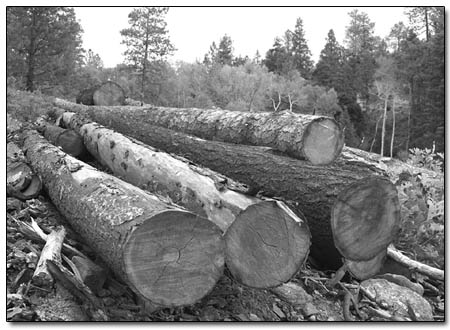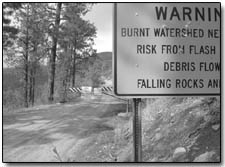 |
| A pile of logged timber awaits
removal on Missionary Ridge Road last week. On July 18,
the San Juan National Forest announced its decision to log
the Missionary Ridge burn area. The logging operation will
cover more than 3,000 acres and harvest some 13.4 million
board feet of timber./Photo by Todd Newcomer. |
New San Juan National Forest Supervisor
Mark Stiles is already stirring up some local controversy. In
his first major decision as the head of local national forest,
Stiles has approved the salvage of dead and dying timber in
the Missionary Ridge burn area just northwest of Durango. Colorado
Wild is calling the decision an outrage and currently looking
into appealing it.
On July 18, Stiles’ decision, which called for a quick
harvest before the wood deteriorates, was made public. The decision
calls for the salvage harvest of 13.4 million board feet of
dead and dying timber on approximately 3,388 acres. A combination
of ground-based, helicopter and skyline logging systems would
be used. Of this timber, roughly 85 percent would be pine, spruce
and fir, and the remainder would be aspen. The decision calls
for the reconstruction of 76 miles of existing roads and construction
of 3 new miles of temporary roads. Following the harvest, the
Forest Service says the areas will be reforested.
When the draft environmental impact statement was released
this spring, it drew widespread criticism from the local environmental
community. At that time, Jeff Berman, Colorado Wild executive
director called it “one of the sloppiest environmental
impact statements” he had ever seen.
“They should take this back 85” he said, “there
are whole issues missing. There are a bunch of scientific issues
that are not even addressed.”
Now, after a comment period and analysis by the Forest Service,
Berman’s opinion has not changed. “They failed to
correct glaring shortcomings with the environmental impact statement
and simply wrote off everyone’s comments,” he said.
Berman continued, “It’s pretty unfortunate that
the Forest Service would focus its efforts on an ill-conceived
logging project like this, when there’s so much thinning
and logging that needs to be done around homes and in the urban/wild
interface.”
Dave Dallison, timber program leader for the San Juan National
Forest, does not believe that the project is ill conceived.
“The primary purpose of the program is to salvage dead
and dying timber that would otherwise be lost,” he said.
“We’d like to do that without causing significant
resource damage. Two of the side benefits would be fuels reduction
for future wildfire situations and the destruction of some beetle
populations.”
 |
Warning signs and a locked
gate on Missionary Ridge Road inform passersby of the ongoing
danger caused by last year's fire. Salvage logging in the
burn area calls for the use of the road as well as reconstruction
of 76 miles of existing roads and construction of 3 miles
of new ones./Photo by Todd Newcomer. |
Originally, the harvest of 20 million board feet of lumber
was proposed. Dallison said that the reduction to 13.4 million
board feet was related to the realities of the site rather than
opposition to the sale.
“The original proposal was basically what had a possibility
of being salvaged,” he said. “Once we got out on
the ground and saw what’s physically and financially feasible,
those numbers went down.”
As for opposition to the sale, Dallison acknowledged that Colorado
Wild, the Environmental Protection Agency, San Juan Citizens’
Alliance, the Town of Bayfield and the La Plata County engineer
had lodged concerns in writing. However, he said written comments
from the general public on the logging were nearly nonexistent,
and comments aired during public scoping meetings were generally
positive.
“We really didn’t get a lot from the general public,”
Dallison said. “There was quite a bit of positive feedback
from the public during the scoping process.”
As for environmental concerns, Dallison said the Forest Service
recognizes that the logging will take place in the watershed
and is trying to take a sensitive approach.
“Our original intent was that we really don’t want
to do significant watershed damage,” he said. “We’ve
proposed to use the existing road system on Missionary Ridge
which is extensive.”
Another criticism of the sale is that it has been rushed through
the public process, a factor that Dallison acknowledged as necessary
given the deterioration of the timber. “It was as fast
as the process would allow us to do it,” he said. “There
were some allegations that we were pushing it, which I guess
is true. It’s a situation where we had to do it quickly
or not at all.”
However, despite these seemingly best intentions, Berman is
crying foul and says the timber sale is too massive, rushed,
reckless and as a total clear-cut, would be potentially damaging
to the environmental and social fabric of La Plata County. He
added that Missionary Ridge is the one case in Colorado where
Forest Service officials deliberately ignored scientific finding
and fact.
“Unfortunately, with the Missionary Ridge final decision,
the Forest Service has not only ignored local concerns, it has
ignored scientific concerns and approved as much logging as
it legally could,” he said.
In terms of scientific concerns, Berman referenced the Beschta
Report, which was authored by eight scientists and endorsed
by 50 others and details resource impacts from post-fire salvage
logging. Berman said that with respect to Missionary Ridge,
and only Missionary Ridge, the Forest Service completely neglected
the report.
“They’re doing things that every other forest district
in the State of Colorado rejected as being too risky,”
Berman said.
Berman said these facts are particularly disturbing since three
municipal water supplies will be affected by logging on Missionary
Ridge.
As a result, Colorado Wild is looking into appealing the decision.
However, prior to an appeal, the conservation organization will
be doing its homework since an appeal will likely become a lawsuit
after it is rejected, Berman said.
“We are looking at the possibility of appealing depending
on the legal strength of our points,” Berman said. “We
assume that an appeal will be denied, and we will have to take
our case to court.”
The appeal period closes Sept. 2, and Dallison said that if
no appeals are filed, logging on Missionary Ridge will likely
begin in October.

